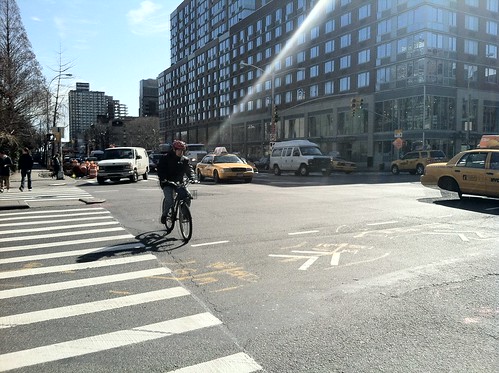Ten East Village intersections have been targeted for improvement by the Department of Transportation, including one – the intersection of Houston and Bowery – that has seen a bevy of biking accidents.
Last night at a joint meeting of Community Boards 2 and 3, the department unveiled the findings of a two-year survey covering a southern portion of the East Village as well as portions of Greenwich Village, NoLIta, and the Lower East Side. The study, which can be seen below, identified 15 intersections (10 of them in the East Village) that the city will target for future makeovers, including five intersections (one in the East Village) that were said to be “high accident locations.” From 2008 to 2010, the intersection of Avenue A and First Street saw 25 accidents, 18 of which resulted in injuries and one of which resulted in the death of a pedestrian.
Though the intersection of Houston Street and Bowery wasn’t among those identified by the D.O.T. as the most dangerous, it was that crossing – the city’s most accident-prone intersection for bicyclists from 1995 to 2009 – that initiated the study to begin with, and it was the one most East Village residents spoke up about. The study found noticeable congestion at the intersection, where 10 to 15 percent of daytime vehicles were trucks, and noted that it was in need of changes to better accommodate turns.
Charle-John Cafiero, who has lived in the East Village for more than 35 years, said he won’t even get near the infamous intersection. “I’ll not cross [Houston] at Bowery,” said Mr. Cafiero, who prefers to walk over to Second Avenue in order to cross the congested east-west artery.
Mr. Cafiero said that accidents happen in part because of the high number of pedestrians who are unfamiliar with the East Village’s streets. “We have people coming down here as a destination. From Broadway all the way over east, it’s just jammed with people day and night.”
Community Board 3 District Manager Susan Stetzer also cited noise concerns. “You know how we have late night congestion and noise at Houston and Bowery?” said Ms. Stetzer, addressing Department of Transportation representatives. “D.O.T. is giving permits for jackhammers at 6 and 7 a.m. on Saturday and Sunday mornings. A short term improvement would be no noisy work on weekends before 9 a.m.”
Jeanne Wilcke, who has lived on Bleecker and Elizabeth Streets for more than 21 years, identified another problematic intersection. “Where Bleecker terminates at the Bowery, it needs to be connected with the light on First Street and Bowery,” she said. “That’s what bottles up that gridlock and you can’t cross.”
The study identified Bleecker Street at Broadway, where eastbound vehicles block the intersection, and Bleecker Street at Bowery, where congestion prevents vehicles from accessing Bowery, as candidates for improvement. Other East Village locations up for potential changes include Bowery north of Houston Street, where traffic signals could be better coordinated, and Houston and Broadway, where pedestrians prevent vehicles from turning.
Residents at the meeting proposed a variety of solutions, including more parking for cars and bikes, clearer traffic signals, more pedestrian crossing time at intersections and a safer (and better looking) median on the Bowery.
To identify the crossings that need the most attention, the D.O.T. collected data on the study zone’s demographics, modes of transportation, land use and zoning, public transit, parking, pedestrian and bicycle traffic, and accidents, in addition to soliciting community input. The transportation agency hopes to propose a list of “concrete solutions” for greater safety and better traffic flow at the designated problem spots by the end of the calendar year.





